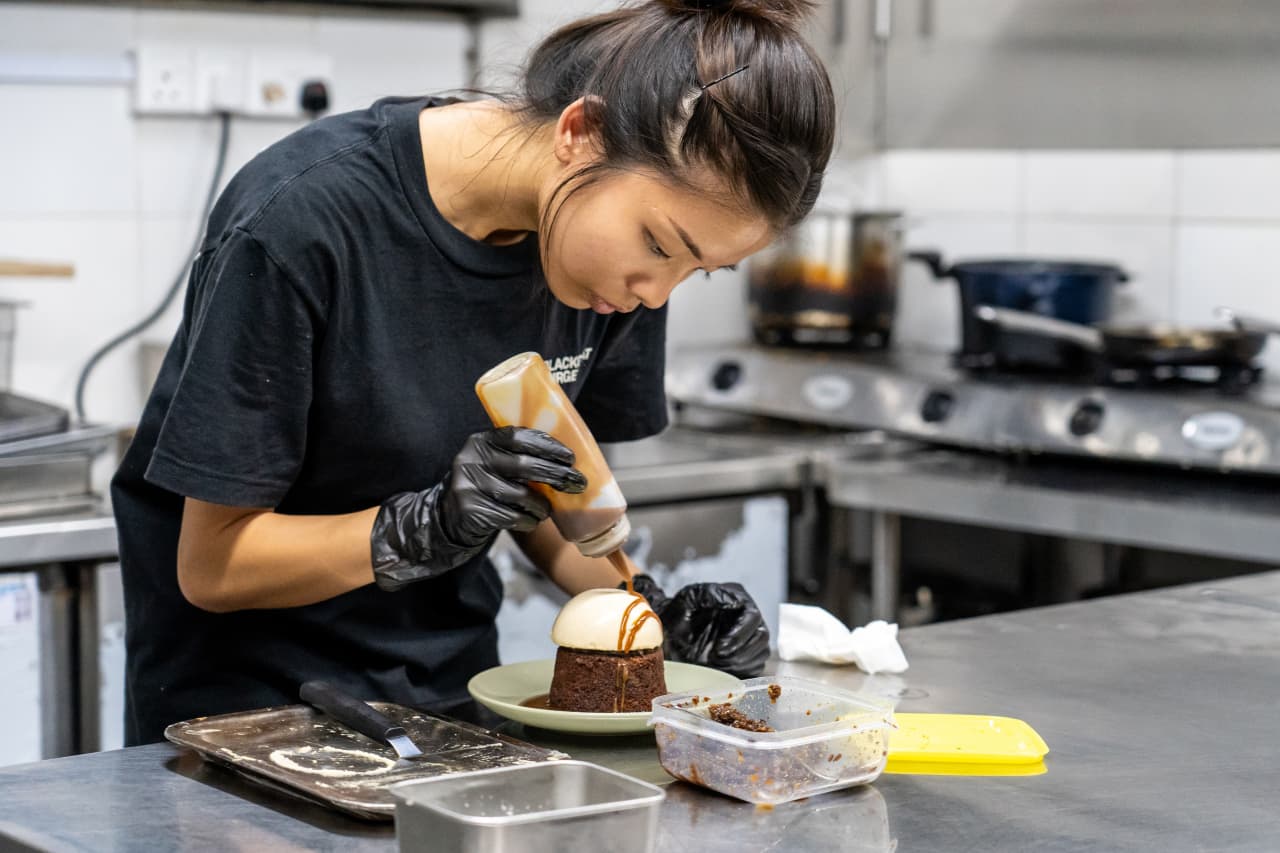How to Avoid the 5 Most Common Dining Room Decorating Mistakes
Advice on sidestepping the decor gaffes that design pros see most often in rooms meant to fire up appetites—from unpalatable wall colours to stingy rugs
DINING ROOM décor gone awry can kill appetites. Whether your guests are flinching from an eerie portrait their chairs face or squeezing into too-tight seats, bad decorating can take the joy out of even the most well-concocted meal.
Los Angeles-based designer David Netto believes dinner guests are rarely eager to enter these stuffy rooms. “So what a dining room must have, above all, is atmosphere,” he said. Here, interiors pros detail five mood crushers in dining rooms, and palate-pleasing alternatives.
1. Blinding Lights
Ample light helps diners distinguish between mashed yams and potatoes, but cruelly aggressive bulbs inspire squinting, not conviviality. “Nothing will kill the vibe of a dinner party faster than harsh overhead lighting,” said Marina Medina, a Vancouver-based interior designer. No one feels good under 5000K LED bulbs, says Susane Jory, a designer in London, Ontario, “and few of us look good bathed in it.”
Instead: Kelly Finley, a designer at Joy Street Design in Oakland, Calif., relies on “recessed lighting on a dimmer, a chandelier with soft lightbulbs and wall sconces” for a softer shine. Mark Eckstrom votes for the old-timey romance of candlelight. Said the co-founder of Studio Eckström, in Omaha, Neb., “Every guest at your table should have faces aglow.”
2. Tasteless Walls
Think of a dining room’s walls as a platter on which dinner is served. Sterile white dishes with a hospital vibe often don’t flatter food. Nor do chaotically patterned ones. Similarly, when it comes to walls, some color can help, but Mr. Eckstrom returns to the effect décor has on complexions: “Sorry, but nobody looks good in a yellow or chartreuse room.” And Brian del Toro, a New York City interior designer, warns against surfaces with “overly active patterns, colours which are too bright or distracting, and combinations of the two, which aren’t soothing.”
Instead: Save the pattern-on-pattern alchemy for the powder room, and pursue colors like terracotta, rose and aubergine that Mr. Eckstrom says “stimulate appetite and reflect well on guests’ skin.” But know that naked walls don’t make people feel comfortable and sociable either. “Every seat should have a view—a window, art, sculpture, wallpaper, mirror, flowers,” he said.
3. Prissiness
You won’t feel inspired to plop down at your dining table for a casual brunch if it’s surrounded by austere crystal chandeliers and dusty mahogany sideboards. Mr. del Toro finds that most dining rooms skew too formal, dark and “limited,” appealing only for an evening dinner.
Instead: “Most of us lead relatively informal lives,” said Mr. del Toro, who likes dining rooms casual enough for sipping a smoothie or morning latte. Chris Goddard, an interior designer in Springdale, Ark., said he’s partial to installing weathered wood tables that, while inherently chillaxed, can be “dressed to the nines for a festive dinner.”
4. Sound-Bouncing Surfaces
When you ponder your dining room’s décor, remember that happy repasts aren’t silent. Poor acoustics can turn animated chatting into cacophony, said Olle Lundberg, a San Francisco designer. “Hard surfaces like stone flooring, plaster walls and large windows all bounce the sound back into the space, creating reverberation,” warned Mr. Lundberg.
Instead: For a more discussion-friendly space, Mr. Eckstrom prescribes a blend of softer materials like drapery, carpet, tapestries or a tablecloth “that help absorb echoes and promote conversation.” Mr. Lundberg goes further, endorsing the idea of covering walls with fabric or draping it from the ceiling. Many textiles come in “large formats and can often be installed seamlessly,” he said.
5. Failures of Scale
In a dining room, ill-fitting furniture is more than an eyesore—it can result in stubbed toes and dry-cleaning bills. “If you’ve placed a giant table in a small room,” said Ms. Jory, “your guests will invariably be wearing the soup as you squeeze behind them with the gazpacho.”
Even the size of a carpet can throw a wrench in the roast. “Rugs that are too small pinch the overall vignette,” said Jessica Lynn Williams, founder of Hendley & Co, in Newburgh, N.Y., who adds you should never force your guests to scooch their chairs awkwardly over the edge of a too-tiny rug.
Instead: An occupied chair should ideally have 3 feet of space behind it for proper circulation and flow, said Meg Lavalette, founder of Lava Interiors in New York City. And carpets should accommodate sliding chairs—without giving them any lip. Laura W. Jenkins, an interior designer in Atlanta, says that when it comes to light fixtures and rugs, she prefers to err on the side of a little too big.
DIGESTION IMPOSSIBLE
Designers recall meal-spoiling decorating gaffes
“Once I saw a light fixture that hung so low and so close to the edges of the table that even the older kids in that family complained about bonking their heads against it!” —Noz Nozawa, interior designer, San Francisco
“I tried to convince [a client that] even though red was his favourite colour, it wasn’t a great choice for a dining space and that we could bring it in through other avenues—décor, rugs, wallpaper. We ended up not taking him on because he couldn’t get past the red for the dining room, but it was so bad.” —Shaolin Low, interior designer, Honolulu
“I was once seated in a dining room with a table that was too small. The chairs were covered in Fortuny, but not even the chicest choice of fabric could keep my knees from bumping against the person who was sitting next to me.” —Michelle Nussbaumer, interior designer, Dallas
 Copyright 2020, Dow Jones & Company, Inc. All Rights Reserved Worldwide. LEARN MORE
Copyright 2020, Dow Jones & Company, Inc. All Rights Reserved Worldwide. LEARN MORE
This stylish family home combines a classic palette and finishes with a flexible floorplan
Just 55 minutes from Sydney, make this your creative getaway located in the majestic Hawkesbury region.
No trip to Singapore is complete without a meal (or 12) at its hawker centres, where stalls sell multicultural dishes from generations-old recipes. But rising costs and demographic change are threatening the beloved tradition.
In Singapore, it’s not unusual for total strangers to ask, “Have you eaten yet?” A greeting akin to “Good morning,” it invariably leads to follow-up questions. What did you eat? Where did you eat it? Was it good? Greeters reserve the right to judge your responses and offer advice, solicited or otherwise, on where you should eat next.
Locals will often joke that gastronomic opinions can make (and break) relationships and that eating is a national pastime. And why wouldn’t it be? In a nexus of colliding cultures—a place where Malays, Indians, Chinese and Europeans have brushed shoulders and shared meals for centuries—the mix of flavours coming out of kitchens in this country is enough to make you believe in world peace.
While Michelin stars spangle Singapore’s restaurant scene , to truly understand the city’s relationship with food, you have to venture to the hawker centres. A core aspect of daily life, hawker centres sprang up in numbers during the 1970s, built by authorities looking to sanitise and formalise the city’s street-food scene. Today, 121 government-run hawker centres feature food stalls that specialise in dishes from the country’s various ethnic groups. In one of the world’s most expensive cities, hawker dishes are shockingly cheap: A full meal can cost as little as $3.
Over the course of many visits to Singapore, I’ve fallen in love with these places—and with the scavenger hunts to find meals I’ll never forget: delicate bowls of laksa noodle soup, where brisk lashes of heat interrupt addictive swirls of umami; impossibly flaky roti prata dipped in curry; the beautiful simplicity of an immaculately roasted duck leg. In a futuristic and at times sterile city, hawker centres throw back to the past and offer a rare glimpse of something human in scale. To an outsider like me, sitting at a table amid the din of the lunch-hour rush can feel like glimpsing the city’s soul through all the concrete and glitz.
So I’ve been alarmed in recent years to hear about the supposed demise of hawker centres. Would-be hawkers have to bid for stalls from the government, and rents are climbing . An upwardly mobile generation doesn’t want to take over from their parents. On a recent trip to Singapore, I enlisted my brother, who lives there, and as we ate our way across the city, we searched for signs of life—and hopefully a peek into what the future holds.
At Amoy Street Food Centre, near the central business district, 32-year-old Kai Jin Thng has done the math. To turn a profit at his stall, Jin’s Noodle , he says, he has to churn out at least 150 $4 bowls of kolo mee , a Malaysian dish featuring savoury pork over a bed of springy noodles, in 120 minutes of lunch service. With his sister as sous-chef, he slings the bowls with frenetic focus.
Thng dropped out of school as a teenager to work in his father’s stall selling wonton mee , a staple noodle dish, and is quick to say no when I ask if he wants his daughter to take over the stall one day.
“The tradition is fading and I believe that in the next 10 or 15 years, it’s only going to get worse,” Thng said. “The new generation prefers to put on their tie and their white collar—nobody really wants to get their hands dirty.”
In 2020, the National Environment Agency , which oversees hawker centres, put the median age of hawkers at 60. When I did encounter younger people like Thng in the trade, I found they persevered out of stubbornness, a desire to innovate on a deep-seated tradition—or some combination of both.
Later that afternoon, looking for a momentary reprieve from Singapore’s crushing humidity, we ducked into Market Street Hawker Centre and bought juice made from fresh calamansi, a small citrus fruit.
Jamilah Beevi, 29, was working the shop with her father, who, at 64, has been a hawker since he was 12. “I originally stepped in out of filial duty,” she said. “But I find it to be really fulfilling work…I see it as a generational shop, so I don’t want to let that die.” When I asked her father when he’d retire, he confidently said he’d hang up his apron next year. “He’s been saying that for many years,” Beevi said, laughing.
More than one Singaporean told me that to truly appreciate what’s at stake in the hawker tradition’s threatened collapse, I’d need to leave the neighbourhoods where most tourists spend their time, and venture to the Heartland, the residential communities outside the central business district. There, hawker centres, often combined with markets, are strategically located near dense housing developments, where they cater to the 77% of Singaporeans who live in government-subsidised apartments.
We ate laksa from a stall at Ghim Moh Market and Food Centre, where families enjoyed their Sunday. At Redhill Food Centre, a similar chorus of chattering voices and clattering cutlery filled the space, as diners lined up for prawn noodles and chicken rice. Near our table, a couple hungrily unwrapped a package of durian, a coveted fruit banned from public transportation and some hotels for its strong aroma. It all seemed like business as usual.
Then we went to Blackgoat . Tucked in a corner of the Jalan Batu housing development, Blackgoat doesn’t look like an average hawker operation. An unusually large staff of six swirled around a stall where Fikri Amin Bin Rohaimi, 24, presided over a fiery grill and a seriously ambitious menu. A veteran of the three-Michelin-star Zén , Rohaimi started selling burgers from his apartment kitchen in 2019, before opening a hawker stall last year. We ordered everything on the menu and enjoyed a feast that would astound had it come out of a fully equipped restaurant kitchen; that it was all made in a 130-square-foot space seemed miraculous.
Mussels swam in a mushroom broth, spiked with Thai basil and chives. Huge, tender tiger prawns were grilled to perfection and smothered in toasted garlic and olive oil. Lamb was coated in a whisper of Sichuan peppercorns; Wagyu beef, in a homemade makrut-lime sauce. Then Ethel Yam, Blackgoat’s pastry chef prepared a date pudding with a mushroom semifreddo and a panna cotta drizzled in chamomile syrup. A group of elderly residents from the nearby towers watched, while sipping tiny glasses of Tiger beer.
Since opening his stall, Rohaimi told me, he’s seen his food referred to as “restaurant-level hawker food,” a categorisation he rejects, feeling it discounts what’s possible at a hawker centre. “If you eat hawker food, you know that it can often be much better than anything at a restaurant.”
He wants to open a restaurant eventually—or, leveraging his in-progress biomedical engineering degree, a food lab. But he sees the modern hawker centre not just as a steppingstone, but a place to experiment. “Because you only have to manage so many things, unlike at a restaurant, a hawker stall right now gives us a kind of limitlessness to try new things,” he said.
Using high-grade Australian beef and employing a whole staff, Rohaimi must charge more than typical hawker stalls, though his food, around $12 per 100 grams of steak, still costs far less than high-end restaurant fare. He’s found that people will pay for quality, he says, even if he first has to convince them to try the food.
At Yishun Park Hawker Centre (now temporarily closed for renovations), Nurl Asyraffie, 33, has encountered a similar dynamic since he started Kerabu by Arang , a stall specialising in “modern Malay food.” The day we came, he was selling ayam percik , a grilled chicken leg smothered in a bewitching turmeric-based marinade. As we ate, a hawker from another stall came over to inquire how much we’d paid. When we said around $10 a plate, she looked skeptical: “At least it’s a lot of food.”
Asyraffie, who opened the stall after a spell in private dining and at big-name restaurants in the region, says he’s used to dubious reactions. “I think the way you get people’s trust is you need to deliver,” he said. “Singapore is a melting pot; we’re used to trying new things, and we will pay for food we think is worth it.” He says a lot of the same older “uncles” who gawked at his prices, are now regulars. “New hawkers like me can fill a gap in the market, slightly higher than your chicken rice, but lower than a restaurant.”
But economics is only half the battle for a new generation of hawkers, says Seng Wun Song, a 64-year-old, semiretired economist who delves into the inner workings of Singapore’s food-and-beverage industry as a hobby. He thinks locals and tourists who come to hawker centers to look for “authentic” Singaporean food need to rethink what that amorphous catchall word really means. What people consider “heritage food,” he explains, is a mix of Malay, Chinese, Indian and European dishes that emerged from the country’s founding. “But Singapore is a trading hub where people come and go, and heritage moves and changes. Hawker food isn’t dying; it’s evolving so that it doesn’t die.”
This stylish family home combines a classic palette and finishes with a flexible floorplan
Just 55 minutes from Sydney, make this your creative getaway located in the majestic Hawkesbury region.






















